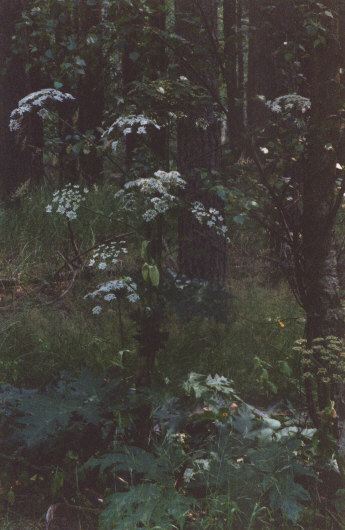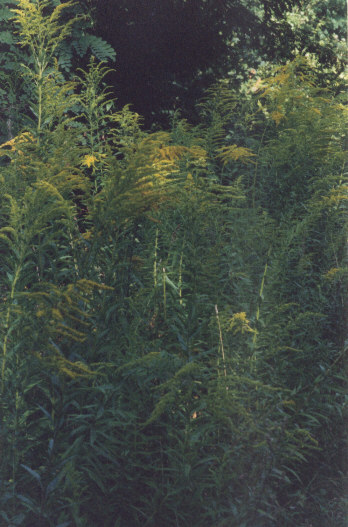
|
"What's left of the unique species of Mauritius is being overrun by stuff that you can find all over the world - privet, guava, all this crap."
Douglas Adams, "Last chance to see..."
|
This gallery is dedicated to the exotic newcomers in our vegetation. It looks as the propagation of these weeds is more important for the nature protection departments than the reintroduction of extinct endemic species. I quote from the book "Orchids in the garden" by Kohls and Kaehler: "In many nature protection areas orchids are diminishing quickly, because even maintenance by humans is forbidden. Near Alfeld a population of Cypripedium calceolus has almost been completely destroyed by growing shrubbery because it was forbidden to thin it out. For similar precedence cases from the real life, if possible with written proof, I would be very grateful.

Solidago canadensis
This incredibly adaptable plant has not accepted her role as a decorative plant in gardens and like the biblical locust plague it has spreaded itself across whole Europe so efficiently that it will probably remain part of our local vegetation forever. It propagates itself with subterranean runners and countless flying seeds. It forms dense colonies in meadows, wastelands and sunny forests, even in swamps. The photo was made near a semi-dry orchid meadow where Orchis militaris and Orchis purpurea plants struggle more or less effectively against the strong alien which dominates in large parts of the meadow.
Heracleum mantegazzianum
This giant plant from east Europe has escaped into the wild in several suitable places. The fan-shaped leaves do not only steal much room and light from other plants, they are also very dangerous for humans. Heracleum mantegazzianum contains a juice which can cause a severe rash with blisters if it contacts the sun-exposed skin. Due to the large roots deep in the ground this plant cannot be extracted easily. This picture was made in a dune area near Mannheim.
Impatiens glandulifera
Frequently passengers ask me about this plant and tell me that they have found orchids - a sign that people do not even know anymore what they have lost. The times when nice mother's day bouquets were made with orchis species have probably passed in most regions. As a replacement nature lovers get this plant which has escaped into the wild as a formerly decorative garden plant. Here it prefers to grow in wet meadows and near brooks, on the Reiss island near Mannheim it forms large colonies and dominates with its size like Heracleum mantegazzianum. Even more widespread is Impatiens parviflora with smaller blossoms and central asiatic origin.
Polygonum cuspidatum/sachalinense
On the Reiss island near Mannheim this exotic Polygonum species creates dense thickets. In such colonies no other plants can grow. Since it has a strong network of roots it cannot be easily removed in areas where it has begun to grow.
Rhus toxicodendron/diversiloba
The american poison ivy (still) isn't a pest in the native vegetation, I would like to present it here to point out the carelessness in treating these aggressive aliens in the academic environment. A sample of this species can be found in the gardens of the university in Kaiserslautern completely unshielded, the only protection is a sign which warns visitors of the gardens not to touch them. In the USA where poison ivy is a native plant it can be found in masses, in the californian redwoods for example it is almost impossible to move without eventually touching some poison oak. This has very unpleasant consequences, even a slight touch of the highly toxic plant causes a long lasting, itching rash. All visitors of botanic gardens should demand that such dangerous plants belong behind glass, an intrusion into the european vegetation would be very dangerous for humans and animals.
Epipactis palustris x gigantea
Another example of bureaucratic madness. Getting autochtone seeds, propagating them and restoring extinct populations back to life is considered "floral falsification". Crossbreeding species from different countries and selling hybrids which cannot be found in the open nature obviously isn't any floral falsification. After several problems with the self-appointed inquisitor types in the government, this is exactly what a very talented gardener has done. Crossbreeds of several Epipactis and Cypripedium species can be found frequently offered from professional orchid nurseries now. It will be only a matter of time until the first bastard plants escape from the gardens. Obviously this still isn't any floral falsification for the concrete heads in the government, while getting permissions to get autochtone seeds has become more difficult than ever before. This leads to the conclusion that the officials plan to destroy the wild orchid populations with their stubbornness and absence of any human reason like they did when they refused to allow people to cut the grass and remove the shrubs for many years. Well, there is at least one good point in the hybrids: They can be used to experiment with bottle culture and biotope creation without even risking to be pissed off by arrogant egocentrics who think they represent god himself. While these guys still rule the nature protection scene, I would recommend to get a CITES document for each non-hybrid plant and remove their seeds to avoid being accused of "floral falsification". Sorry.
Back to the nature protection title page